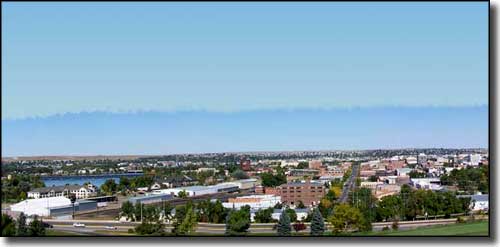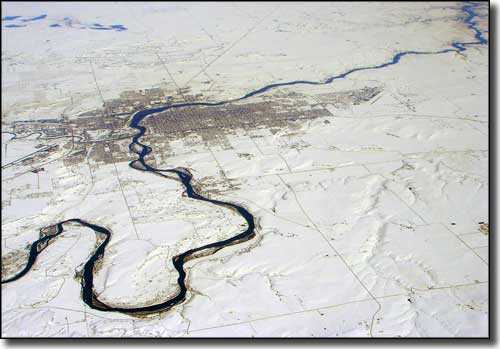 |
Great Falls, Montana |
 Great Falls, Montana |
|
Great Falls was built at the site of the Great Falls of the Missouri River. This was right at the southern edge of the Laurentide Ice Sheet of the Last Ice Age: the Missouri River ran along the southern boundary of that ice sheet for several hundred miles. Within a ten mile distance, the Missouri River in this area drops 512 feet. The big impetus for establishing Great Falls came from Paris Gibson, a politician and industrialist/businessman from Maine and Minnesota. Gibson visited the area of the Great Falls in 1880 and saw a great potential for producing hydroelectric power. He convinced James J. Hill (owner and builder of the Great Northern Railway) to extend a railroad line through the Great Falls area and to invest in a townsite near the falls. The townsite was surveyed and platted in 1883. A store, several houses and a flour mill were built in 1884. By 1887, tracks had been laid and trains were running through Great Falls to the copper mines at Butte and to the gold mines at Helena. The population of Great Falls in 1887 has been estimated at 1,200. For many years, the largest employer in Great Falls was the smelter operation of the Anaconda Copper Mining Company. Anaconda built the "world's tallest smokestack" (508 feet tall) in the city in 1908. The smokestack was demolished in 1983 after the copper smelter had been shut down. In 1891, Black Eagle Dam was built just above Black Eagle Falls. Rainbow Dam was built in 1910 and the Volta Dam (later renamed Ryan Dam) was built in 1915. Today, there are five large hydoelectric facilities on the Missouri River around Great Falls (although two of them are nowhere near any of the old waterfalls). Malmstrom Air Force Base was built at the edge of town in the 1940's and fueled more prosperity in Great Falls. Today, the copper mines and smelter are shut down, operations at Malmstrom have been cut back and rail transportation and freight have dropped off. The area still sees a lot of wheat and grain production but the work is mostly mechanized. Cattle ranching has seen a lot of mechanization over the years, too. One of the big tourism draws in Great Falls is the Charles Marion Russell House and Museum, the home and studio of the famous Western painter and sculptor for the last 30 years of his life. |
 Great Falls and the Missouri River |
| Fast Facts about Great Falls, Montana |
|
Great Falls, Cascade County, MT 59401-59406
Founded: 1883, Incorporated: 1888 Elevation: 3,330' Latitude: 47.5037°N Longitude: 111.2863°W Resident Racial Breakdown: White Non-Hispanic: 87.8% Hispanic: 2.8% African-American: 1.1% Native American: 4.5% Other: 0.7% Two or more races: 3.1% Education: High School or Higher: 87.2% Bachelor's Degree or Higher: 22.4% Graduate or Professional Degree: 7.1%
2009 Estimates: Population: 59,366 Males: 28,803 Females: 30,563 Median Resident Age: 37.8 Years Estimated Median Household Income: $39,300 Estimated Median Home Value: $148,200 Population Density: 3,046 People per Square Mile 2011 Cost of Living Index for Great Falls: 87.3 Major Industries: Health Care, Educational Services, Government, Construction, Lodging & Food Services, Finance & Insurance Services, Professional Services, Social Services Unemployed (March 2011): 7.1% |
|
|
 |
| Index - Arizona - Colorado - Idaho - Montana - Nevada - New Mexico - Utah - Wyoming National Forests - National Parks - Scenic Byways - Ski & Snowboard Areas - BLM Sites Wilderness Areas - National Wildlife Refuges - National Trails - Rural Life Advertise With Us - About This Site - Privacy Policy |
| Upper photo of Great Falls courtesy of the City of Great Falls. Aerial photo of Great Falls and surrounding area courtesy of P199, CCA ShareAlike 3.0 License. Text Copyright © by Sangres.com. All rights reserved. |